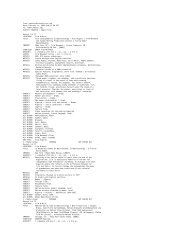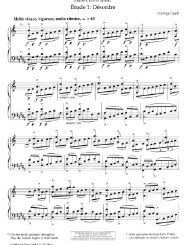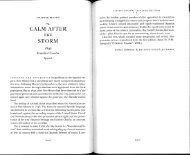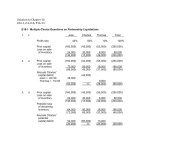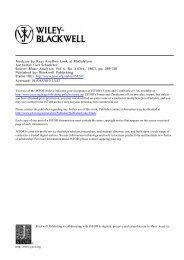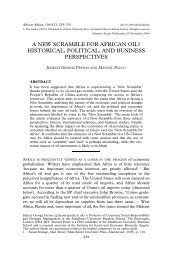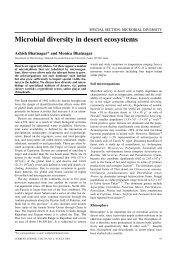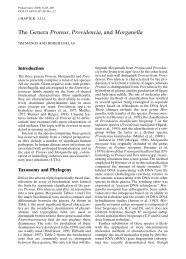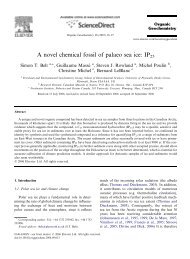The Genus Serratia
The Genus Serratia
The Genus Serratia
You also want an ePaper? Increase the reach of your titles
YUMPU automatically turns print PDFs into web optimized ePapers that Google loves.
CHAPTER 3.3.11 <strong>The</strong> <strong>Genus</strong> <strong>Serratia</strong> 231<br />
FT with adonitol is a poor test for separating<br />
these two species (32% vs. 0% positive strains in<br />
2 days, respectively).<br />
Glucose Oxidation Test<br />
<strong>The</strong> Lysenko test (Lysenko, 1961) was extensively<br />
modified by Bouvet et al. 1989. A 1-liter<br />
portion of glucose oxidation medium is composed<br />
of basal medium containing 8 g of nutrient<br />
broth (Difco), 0.02 g of bromcresol purple, and<br />
0.62 g of MgSO 4·7H 2O (2.5 mM). To 9.2 ml of<br />
autoclaved (121°C, 15 min) basal medium is<br />
added 0.4 ml of a filter-sterilized 1 M D-glucose<br />
solution (final concentration, 40 mM). This<br />
medium is supplemented with 0.4 ml of a fresh,<br />
sterile 25 mM iodoacetate solution (final concentration,<br />
1 mM). <strong>The</strong> glucose oxidation medium is<br />
distributed (0.5 ml portions) into glass tubes (11<br />
by 75 mm), which are plugged with sterile cotton<br />
wool. Bacteria grown overnight at 20 or 30°C<br />
on tryptocasein soy agar (Diagnostics Pasteur,<br />
Marnes-la-Coquette, France) supplemented with<br />
0.2% (wt/vol) D-glucose are collected with a<br />
platinum loop, suspended in a sterile 2.5 mM<br />
MgSO 4 solution and adjusted to an absorbance<br />
(at 600 nm) of about 4. Glucose oxidation<br />
medium is then inoculated with 50µ1 of bacteria<br />
suspension and vigorously shaken at 270 strokes<br />
per minute overnight at 20 or 30°C. <strong>The</strong> test is<br />
positive if a yellow color develop (acid production).<br />
Otherwise, the medium remains purple.<br />
When negative, the glucose oxidation test is<br />
repeated in the presence of 10µM pyrroloquinoline<br />
quinone (PQQ). <strong>The</strong> control strains used are<br />
the type strains of S. marcescens (positive without<br />
requirement for PQQ) and S. liquefaciens<br />
(positive only when PQQ is supplied) (Bouvet<br />
et al., 1989).<br />
Gluconate and 2-Ketogluconate<br />
Dehydrogenase Tests<br />
<strong>The</strong> gluconate dehydrogenase test is performed<br />
as follows (Bouvet et al., 1989): Bacteria are<br />
grown overnight at 20°C on tryptocasein soy<br />
agar supplemented with 0.2% D-gluconate, then<br />
collected with a platinum loop and suspended in<br />
sterile distilled water to an absorbance (at 600<br />
nm) of about 4. <strong>The</strong> reaction medium contains<br />
0.2 M acetate buffer (pH5), 1% (wt/vol) Triton<br />
X-100, 2.5 mM MgSO 4, 75 mM gluconate, and<br />
(added immediately before use) 1 mM iodoacetate.<br />
A control medium contains the same ingredients<br />
except gluconate. <strong>The</strong> reaction medium<br />
and the control medium are dispensed (100µl<br />
portions) into 96-well microtiter plates (Dynatech<br />
AG, Denkendorf, Germany). Bacterial suspensions<br />
(10µl) are added to the reaction and the<br />
control media, and the microtiter plates are incubated<br />
at 20°C for 20 min. <strong>The</strong>n, 10-µl portions of<br />
a 0.1 M potassium ferricyanide solution (kept in<br />
the dark at room temperature for no longer than<br />
1 week) are added to the wells, and the plates are<br />
gently shaken and incubated at 20°C for 40 min.<br />
<strong>The</strong>n 50 µ1 of a reagent containing Fe2(SO 4) 3,0.6<br />
g; sodium dodecyl sulfate, 0.36 g; 85% phosphoric<br />
acid, 11.4 ml; distilled water to 100 ml is added<br />
to each well. <strong>The</strong> plates are examined for the<br />
development of a green- to-blue color (due to<br />
Prussian blue) within 15 min at room temperature.<br />
<strong>The</strong> color in the uninoculated control<br />
medium remains yellow. <strong>The</strong> suggested control<br />
strains used are Escherichia coli K-12 (negative)<br />
and the type strain of <strong>Serratia</strong> marcescens<br />
(positive).<br />
<strong>The</strong> 2-ketogluconate dehydrogenase test is<br />
the same as above, except that the control and<br />
reaction media are adjusted to pH 4.0, and 2ketogluconate<br />
is used in place of gluconate in<br />
the reaction medium. Suggested control strains<br />
used are Escherichia coli K-12 (negative) and the<br />
type strain of <strong>Serratia</strong> marcescens (positive at<br />
20°C, not at 30°C) (Bouvet et al., 1989).<br />
Tetrathionate Reductase Test<br />
<strong>The</strong> tetrathionate reductase test was found to be<br />
very useful for the identification of <strong>Serratia</strong> spp.<br />
<strong>The</strong> liquid medium of Le Minor et al. (1970) is<br />
described below:<br />
Tetrathionate Reductase Test for Identifying <strong>Serratia</strong><br />
spp. (Le Minor et al., 1970)<br />
K2S4O6<br />
5 g<br />
Bromthymol blue (0.2%<br />
aqueous solution) 25 ml<br />
Peptone water (peptone [Difco], 10 g;<br />
NaCl, 5 g; distilled water, 1 liter) Up to 1 liter<br />
Adjust pH to 7.4. Filter-sterilize and dispense 1 ml into<br />
12-x-120-mm tubes. Within 1 or 2 days, reduction of<br />
tetrathionate will acidify the medium, indicated by a yellow<br />
color. Negative tubes remain green or turn blue.<br />
Voges-Proskauer Test<br />
Results of the Voges-Proskauer test are variable<br />
with some <strong>Serratia</strong> spp., probably because the<br />
end products of the butanediol pathway are<br />
metabolized (Grimont et al., 1977b). Many<br />
strains of S. plymuthica and S. odorifera give negative<br />
results with O’Meara’s method (O’Meara,<br />
1931) and positive results with Richard’s procedure<br />
(Richard, 1972). In Richard’s procedure,<br />
0.5-ml aliquots of Clark and Lubs medium<br />
(BBL) are inoculated in 16-mm-wide test tubes.<br />
After overnight incubation at 30°C, 0.5 ml of αnaphthol<br />
(6 g in 100 ml absolute ethyl alcohol)<br />
and 0.5 ml of 4 M NaOH are added. Positive<br />
tubes will turn red.



